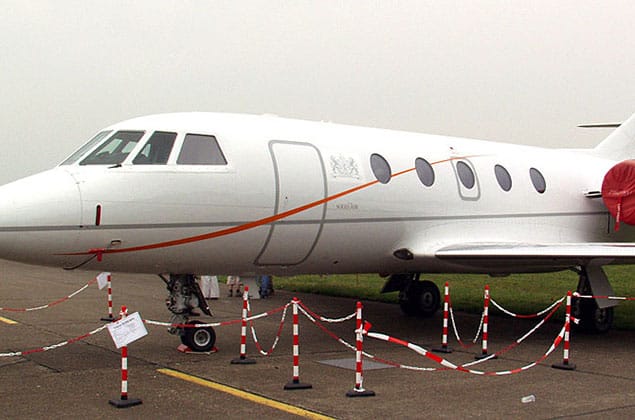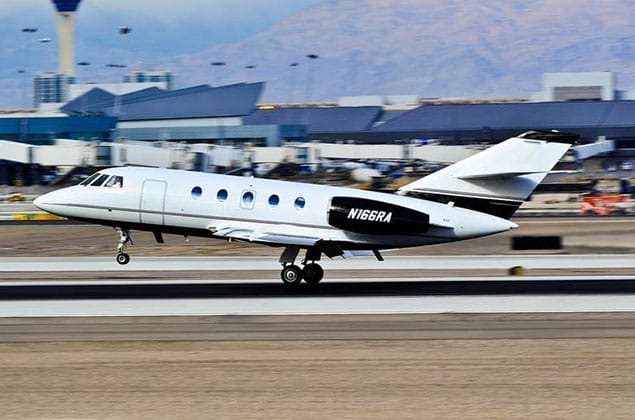Falcon 20 Specifications & Booking
Overview of the Falcon 20
The Dassault Falcon 20 is a business jet manufactured by Dassault Aviation, a French company. It is a medium-range, twin-engine aircraft designed for corporate transportation, charter flights, and VIP travel. The first flight of the Falcon 20 took place on November 4, 1963.
Technical Specifications
The following are the key technical specifications of the Dassault Falcon 20:
- Dimensions:
- Length: 55.6 feet (16.9 meters)
- Wingspan: 52.5 feet (16.1 meters)
- Height: 17.3 feet (5.3 meters)
- Weight:
- Empty weight: 27,000 pounds (12,247 kilograms)
- Maximum takeoff weight: 53,400 pounds (24,255 kilograms)
- Engines:
- Type: General Electric CJ610
- Thrust: 6,600 pounds-force (29.4 kilonewtons) each
- Fuel efficiency: 0.45 pounds per horsepower-hour
- Performance:
- Maximum speed: 530 miles per hour (853 kilometers per hour)
- Range: 3,000 nautical miles (5,556 kilometers)
- Cruising altitude: 41,000 feet (12,500 meters)
- Capacity:
- Passengers: Up to 10 passengers
- Cargo: Up to 2,400 pounds (1,089 kilograms)
- Crew: Two pilots
Design and Features
The Falcon 20 features a distinctive design with a long, pointed nose and a unique wing configuration. The aircraft has a high-aspect-ratio wing, which provides excellent lift-to-drag ratio and efficient cruise performance.
History and Development
The development of the Falcon 20 began in the late 1950s, with the first flight taking place in November 1963. The aircraft entered service in 1965 and was certified by the Federal Aviation Administration (FAA) in December 1966.
- Key milestones:
- First flight: November 4, 1963
- Certification: December 1966
- Entry into service: 1965
- Challenges faced during development:
- Solving the problem of high-lift devices for takeoff and landing
- Improving fuel efficiency through aerodynamic design
- Significant upgrades or variants:
- Falcon 20C: A longer-range variant with a larger fuel tank
- Falcon 20E: An upgraded model with improved avionics and ergonomics
Operational Use
The Falcon 20 is widely used for corporate transportation, charter flights, and VIP travel. It has also been used by military organizations for training and transport missions.
- Airlines or organizations that operate it:
- Air France
- British Airways
- Qantas
- Popular routes or missions:
- Short- to medium-range flights between major cities
- Military training and transport missions
- Role in aviation history:
- Record-breaking flights, including a 1966 flight that set a new record for the fastest transatlantic crossing by a business jet
- Military operations, such as aerial reconnaissance and transport missions
Interesting Facts
The following are some interesting facts about the Dassault Falcon 20:
- Famous flights:
- Around-the-world flight in 1967, flown by a French businessman and his crew
- Unique design choices:
- The Falcon 20's unique wing configuration provides excellent lift-to-drag ratio and efficient cruise performance
- Pop culture appearances:
- The Falcon 20 has been featured in several movies, including the James Bond film "Goldfinger" (1964)
Frequently Asked Questions
What makes the Falcon 20 unique?
The key features that set the Falcon 20 apart from other aircraft include its unique wing configuration, high-aspect-ratio design, and efficient cruise performance.
How much does the Falcon 20 cost?
The price of a used or pre-owned Falcon 20 can vary depending on the model year, condition, and location. On average, a used Falcon 20 can cost anywhere from $500,000 to $2 million.
Is the Falcon 20 still in production?
No, the Falcon 20 is no longer in production. The last Falcon 20 was produced in the early 1980s, and since then, Dassault has focused on producing newer models such as the Falcon 200 and Falcon 7X.
Can you fly a Falcon 20 without a pilot?
No, the Falcon 20 requires a trained pilot to operate it safely. While there are autopilot systems available for the aircraft, flying a Falcon 20 requires manual control and input from a qualified pilot.





